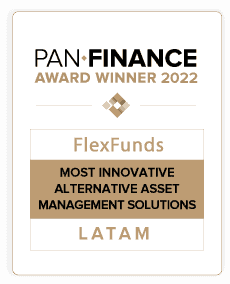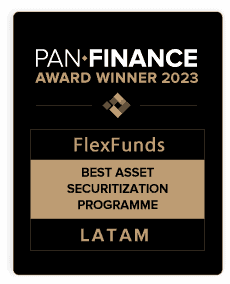- This article outlines what passive and active investing consist of, and the key differences between them.
- The information is intended for asset managers and investors wondering which option is best regarding active vs. passive investing.
- At FlexFunds, we securitize assets to issue exchange-listed products (ETPs) that can enhance diversification and liquidity across active, passive, and hybrid investment strategies. For more information, feel free to contact our team of experts.
The investment world is broad and complex, with countless strategies to protect and grow wealth over time. However, the most popular approaches fall into two main categories: active investing and passive investing.
What is active investing?
Active investing aims to “beat the market”—that is, to generate higher returns than a given index. For example, in the equities space, the goal might be to outperform the S&P 500 or the Nasdaq 100.
To achieve this, investment managers must conduct in-depth analysis to identify opportunities and make decisions based on their forecasts. This includes buying, selling, holding, using derivatives, diversifying, concentrating, and more.
Advantages of active investing
The main advantage of active investing is the potential to achieve higher returns, since the strategies aren’t tied to tracking the performance of a selected index. Additionally, this type of investing allows for strategies that are more closely aligned with the investor’s specific goals and needs.
“With active investing, portfolio managers and investors aren’t required to hold certain stocks and bonds, so they can take advantage of short-term trading opportunities,” explain analysts at Goldman Sachs.
Disadvantages of active investing
On the flip side, active investing comes with two major drawbacks: higher costs and unpredictability.
Since this approach requires a large team of professionals to analyze, build strategies, and manage assets, the fees are typically higher than those of passive investing funds. Over the long term, this can become a significant issue.
In fact, according to the U.S. Securities and Exchange Commission (SEC), over a 20-year period, a 1% annual fee could reduce the value of a $100,000 portfolio by $30,000, compared to a $10,000 reduction with a 0.50% annual fee.
Unfortunately, assuming this difference will be offset by higher returns is a common mistake. This is mainly because the outcomes of active investments can’t be predicted with certainty, as financial asset prices and macroeconomic conditions are constantly changing.
What is passive investing?
Passive investing involves simply buying a specific basket of financial assets to “mirror” the performance of a representative index—such as the S&P 500 or Nasdaq 100.
“The basic idea of passive investing is that markets are efficient. This means that, despite short-term swings, the price of an asset, such as a company stock or government bond, will eventually settle at its fair value,” according to Fidelity.
Pros of passive investing
One of the main advantages of passive investing is its simplicity. By acquiring a single passive fund, an investor or manager can gain exposure to an entire market—usually in a diversified way.
Passive investing is also less complex, as it doesn’t require analyzing individual assets to identify opportunities. This often results in lower fees, and in the long run, that’s a major benefit.
Cons of passive investing
Unfortunately, passive investing isn’t perfect. In fact, with this type of strategy, it’s impossible to “beat the market.” Returns will never exceed those of the chosen benchmark index.
Because a passive fund mirrors market performance, periods of volatility and downturns can’t be avoided, even if projections were based on a growth phase.
“Passive investing is less risky, generally speaking – but as a result it can also be less rewarding. For example, if there’s a promising new company or sector that looks like it’s on the brink of sustained, exponential growth, a passive investing strategy won’t allow you to get in sooner than the rest of the market and end up ahead,” explain experts at JP Morgan.
Active vs. passive investing: Which is better based on client profile?
Now that we’ve reviewed the characteristics of each strategy, the question arises: which is better regarding active vs. passive investing? As is often the case in finance, the answer depends on the investor’s risk profile, knowledge, goals, and needs.
A beginner investor and/or someone who doesn’t want to dedicate much time to managing their investments might be satisfied with a passive strategy. Meanwhile, an experienced professional could benefit more from an active approach. However, in many cases, a hybrid strategy proves to be the ideal solution.
“Depending on the opportunity in different sectors of the capital markets, investors may be able to benefit from mixing both passive and active strategies—the best of both worlds, if you will,” said analysts at Morgan Stanley.
Fortunately, regardless of which strategy an asset manager chooses all of them can be securitized to reach a broader client base in a cost-efficient manner.
This process, carried out by firms like FlexFunds, allows for turning a basket of assets into bankable assets with their own ISIN/CUSIP codes, making them accessible through standard brokerage accounts.
To learn more about FlexFunds’ ETPs and asset securitization program, feel free to contact our team of specialists. We’ll be happy to help!
Sources:
- https://privatewealth.goldmansachs.com/us/en/insights/investing-fundamentals-active-vs-passive-investing
- https://www.sec.gov/investor/alerts/ib_fees_expenses.pdf
- https://www.fidelity.com.sg/beginners/what-is-active-investing/differences-of-active-and-passive-investing
- https://www.chase.com/personal/investments/learning-and-insights/article/the-pros-and-cons-of-passive-investing
- https://www.morganstanley.com/articles/active-vs-passive-investing







